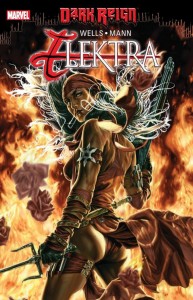 This month, Netflix’s Daredevil series adds a much-anticipated character: Elektra. Elektra debuted in Marvel comics in the 1980s. The recap page of the 2009 miniseries Dark Reign: Elektra describes her thusly: “Elektra Natchios was the most dangerous woman in the world: an assassin, master martial artist, and weapons expert.” I had never read any comics starring Elektra, so I picked up this miniseries to learn more about her. Writer Zeb Wells begins the five-issue story immediately after Elektra experiences severe trauma, and shows her piecing together why assassins want to kill her.
This month, Netflix’s Daredevil series adds a much-anticipated character: Elektra. Elektra debuted in Marvel comics in the 1980s. The recap page of the 2009 miniseries Dark Reign: Elektra describes her thusly: “Elektra Natchios was the most dangerous woman in the world: an assassin, master martial artist, and weapons expert.” I had never read any comics starring Elektra, so I picked up this miniseries to learn more about her. Writer Zeb Wells begins the five-issue story immediately after Elektra experiences severe trauma, and shows her piecing together why assassins want to kill her.
The series kicks off with Elektra unconscious and captive in the science lab of H.A.M.M.E.R., S.H.I.E.L.D.’s new, more sinister iteration. Elektra has already just been held prisoner: in the 2008 Marvel comics event Secret Invasion, many of Earth’s superheroes were abducted and replaced by shapeshifting aliens called Skrulls. Not only was Elektra one of these victims, but mysteriously, she alone was subjected to the worst kinds of experimentation.
Once Elektra regains consciousness in H.A.M.M.E.R.’s lab, Clay Mann and Matt Hollingsworth illustrate an action sequence worthy of Elektra’s reputation as a master assassin: she takes on a squadron of machine gun-carrying agents with only a knife. She ingeniously triggers the sprinklers to bathe the room in mist to mask her movements. There’s a flurry of gunshots and bodies recoiling as Elektra takes out each agent. Elektra barely speaks few words throughout the first two issues, and her facial expressions are always drawn as impassive. Her imperceptibility is furthered by the series’ lack of narration or internal monologue.
 Wells briefly addresses the theme of a trauma victim being disbelieved or seen as using her trauma as an excuse. In the third issue, Elektra awakes in the hospital under the care of the Night Nurse. The Night Nurse heard that Elektra had been impersonated by a Skrull and remarks, “You could just be playing the Skrull thing like a ‘Get Out of Jail Free’ card.” I wish Wells had explored this theme more. Wells also includes but doesn’t examine the horrific theme of meeting a past abuser. Elektra faces Bullseye, the villain who killed her in the past, but a quick fight scene abruptly ends the interaction.
Wells briefly addresses the theme of a trauma victim being disbelieved or seen as using her trauma as an excuse. In the third issue, Elektra awakes in the hospital under the care of the Night Nurse. The Night Nurse heard that Elektra had been impersonated by a Skrull and remarks, “You could just be playing the Skrull thing like a ‘Get Out of Jail Free’ card.” I wish Wells had explored this theme more. Wells also includes but doesn’t examine the horrific theme of meeting a past abuser. Elektra faces Bullseye, the villain who killed her in the past, but a quick fight scene abruptly ends the interaction.
Elektra’s silence is one of this series’ most glaring and disturbing traits. Wells joins a group of all men who have written Elektra’s solo series: Frank Miller, Brian Michael Bendis, Peter Milligan, Greg Rucka, Akira Yoshida, and Haden Blackman. Why hasn’t a woman written Elektra? Why is Elektra depicted primarily as a trauma victim, as male writers have so often portrayed Black Widow, Spider-Woman, and Captain Marvel? While Elektra gets some small victories in this miniseries, the reader is never clued in to how she’s processing her experiences. In five issues, we never hear Elektra verbally express an opinion or desire.
Dark Reign: Elektra has impressive art, but Elektra is portrayed more as the object of villains’ discussion than the subject choosing what she’ll do next. Netflix’s Daredevil would disappoint if it emulated the shallow treatment of Elektra in this miniseries. If you’re looking for comics where Elektra is the star and not the tragic plot device, skip this one.

